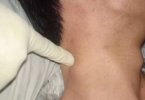
What's in this article?
The most dangerous form of skin cancer, these cancerous growths develop when unrepaired DNA damage to skin cells (most often caused by ultraviolet radiation from sunshine or tanning beds) triggers mutations (genetic defects) that lead the skin cells to multiply rapidly and form malignant tumors. These tumors originate in the pigment-producing melanocytes in the basal layer of the epidermis. Melanomas often resemble moles; some develop from moles. The majority of melanomas are black or brown, but they can also be skin-colored, pink, red, purple, blue or white. Melanoma is caused mainly by intense, occasional UV exposure (frequently leading to sunburn), especially in those who are genetically predisposed to the disease. Melanoma kills an estimated 10,130 people in the US annually.
If melanoma is recognized and treated early, it is almost always curable, but if it is not, the cancer can advance and spread to other parts of the body, where it becomes hard to treat and can be fatal. While it is not the most common of the skin cancers, it causes the most deaths. In 2016, an estimated 76,380 of these will be invasive melanomas, with about 46,870 in males and 29,510 in women.
Melanoma Symptoms
Melanomas can develop anywhere on your body. They most often develop in areas that have had exposure to the sun, such as your back, legs, arms and face.
Melanomas can also occur in areas that don’t receive much sun exposure, such as the soles of your feet, palms of your hands and fingernail beds. These hidden melanomas are more common in people with darker skin.
The first melanoma signs and symptoms often are:
- A change in an existing mole
- The development of a new pigmented or unusual-looking growth on your skin
Melanoma doesn’t always begin as a mole. It can also occur on otherwise normal-appearing skin.
Normal moles
Normal moles are generally a uniform color such as tan, brown or black with a distinct border separating the mole from your surrounding skin. They’re oval or round and usually smaller than 1/4 inch (about 6 millimeters) in diameter the size of a pencil eraser.
Most people have between 10 and 45 moles. Many of these develop by age 50, although moles may change in appearance over time some may even disappear with age.
Unusual moles that may indicate melanoma
To help you identify characteristics of unusual moles that may indicate melanomas or other skin cancers, think of the letters ABCDE:
- A is for asymmetrical shape. Look for moles with irregular shapes, such as two very different-looking halves.
- B is for irregular border. Look for moles with irregular, notched or scalloped borders characteristics of melanomas.
- C is for changes in color. Look for growths that have many colors or an uneven distribution of color.
- D is for diameter. Look for new growth in a mole larger than 1/4 inch (about 6 millimeters).
- E is for evolving. Look for changes over time, such as a mole that grows in size or that changes color or shape. Moles may also evolve to develop new signs and symptoms, such as new itchiness or bleeding.
Cancerous (malignant) moles vary greatly in appearance. Some may show all of the changes listed above, while others may have only one or two unusual characteristics.

Hidden melanomas
Melanomas can also develop in areas of your body that have little or no exposure to the sun, such as the spaces between your toes and on your palms, soles, scalp or genitals. These are sometimes referred to as hidden melanomas because they occur in places most people wouldn’t think to check. When melanoma occurs in people with darker skin, it’s more likely to occur in a hidden area.
Hidden melanomas include:
- Melanoma under a nail. Acral-lentiginous melanoma is a rare form of melanoma that can occur under a fingernail or toenail. It can also be found on the palms of the hands or the soles of the feet. It’s more common in blacks and in other people with darker skin pigment.
- Melanoma in the mouth, digestive tract, urinary tract or vagina. Mucosal melanoma develops in the mucous membrane that lines the nose, mouth, esophagus, anus, urinary tract and vagina. Mucosal melanomas are especially difficult to detect because they can easily be mistaken for other far more common conditions.
- Melanoma in the eye. Eye melanoma, also called ocular melanoma, most often occurs in the uvea the layer beneath the white of the eye (sclera). An eye melanoma may cause vision changes and may be diagnosed during an eye exam.
Causes of Melanoma
Most skin cancer is caused by ultraviolet (UV) light damaging the DNA in skin cells. The main source of UV light is sunlight.
Sunlight contains three types of UV light:
- ultraviolet A (UVA)
- ultraviolet B (UVB)
- ultraviolet C (UVC)
UVC is filtered out by the Earth’s atmosphere, but UVA and UVB damage skin over time, making it more likely for skin cancers to develop. UVB is thought to be the main cause of skin cancer.
Artificial sources of light, such as sunlamps and tanning beds, also increase your risk of developing skin cancer.
Repeated sunburn, either by the sun or artificial sources of light, increases the risk of melanoma in people of all ages.
Moles
You are at an increased risk of melanoma if you have lots of moles on your body, especially if they are large (over 5mm) or unusually shaped.
Having just one unusually shaped or very large mole increases your risk of melanoma by 60%.
For this reason, it’s important to monitor moles for changes and avoid exposing them to the sun.
Family history
Research suggests that if you have two or more close relatives who have had non-melanoma skin cancer, your chances of developing the condition may be increased.
Increased risk
Certain things are believed to increase your chances of developing all types of skin cancer, including:
- pale skin that does not tan easily
- red or blonde hair
- blue eyes
- older age
- a large number of freckles
- an area of skin previously damaged by burning or radiotherapy treatment
- a condition that suppresses your immune system such as HIV
- medicines that suppress your immune system (immunosuppressants) commonly used after organ transplants
- exposure to certain chemicals such as creosote and arsenic
- a previous diagnosis of skin cancer
Melanoma Diagnosis
To diagnose melanoma, a dermatologist begins by looking at the patient’s skin. A dermatologist will carefully examine moles and other suspicious spots. To get a better look, a dermatologist may use a device called a dermoscope. The device shines light on the skin. It magnifies the skin. This helps the dermatologist to see pigment and structures in the skin.
The dermatologist also may feel the patient’s lymph nodes. Many people call these lymph glands.
If the dermatologist finds a mole or other spot that looks like melanoma, the dermatologist will remove it (or part of it). The removed skin will be sent to a lab. Your dermatologist may call this a biopsy. Melanoma cannot be diagnosed without a biopsy.
This biopsy is quick, safe, and easy for a dermatologist to perform. This type of biopsy should not cause anxiety. The discomfort and risks are minimal.
If the biopsy report says that the patient has melanoma, the report also may tell the stage of the melanoma. Stage tells the doctor how deeply the cancer has grown into the skin.
Sometimes the patient needs another type of biopsy. A type of surgery called a sentinel lymph node biopsy (SLNB) may be recommended to stage the melanoma. When melanoma spreads, it often goes to the closest lymph nodes first. A SLNB tells doctors whether the melanoma has spread to nearby lymph nodes. Other tests that a patient may need include x-rays, blood work, and a CT scan.
Melanoma Treatment
The type of treatment a patient receives depends on the following:
- How deeply the melanoma has grown into the skin.
- Whether the melanoma has spread to other parts of the body.
- The patient’s health.
The following describes treatment used for melanoma.
Surgery: When treating melanoma, doctors want to remove all of the cancer. When the cancer has not spread, it is often possible for a dermatologist to remove the melanoma during an office visit. The patient often remains awake during the surgical procedures described below. These procedures are used to remove skin cancer:
- Excision: To perform this, the dermatologist numbs the skin. Then, the dermatologist surgically cuts out the melanoma and some of the normal-looking skin around the melanoma. This normal-looking skin is called a margin. There are different types of excision. Most of the time, this can be performed in a dermatologist’s office.
- Mohs surgery: A dermatologist who has completed additional medical training in Mohs surgery performs this procedure. Once a dermatologist completes this training, the dermatologist is called a Mohs surgeon.
Mohs surgery begins with the Mohs surgeon removing the visible part of the melanoma. Next, the surgeon begins removing the cancer cells. Cancer cells are not visible to the naked eye, so the surgeon removes skin that may contain cancer cells one layer at a time. After removing a layer, it is prepped so that the surgeon can examine it under a microscope and look for cancer cells. This layer-by-layer approach continues until the surgeon no longer finds cancer cells. In most cases, Mohs surgery can be completed within a day or less. Mohs has a high cure rate.
When caught early, removing the melanoma by excision or Mohs may be all the treatment a patient needs. In its earliest stage, melanoma grows in the epidermis (outer layer of skin). Your dermatologist may refer to this as melanoma in situ or stage 0. In this stage, the cure rate with surgical removal is nearly 100%.
When melanoma grows deeper into the skin or spreads, treatment becomes more complex. It may begin with one of the surgeries described above. A patient may need more treatment. Other treatments for melanoma include:
- Lymphadenectomy: Surgery to remove lymph nodes.
- Immunotherapy: Treatment that helps the patient’s immune system fight the cancer.
- Targeted therapy: Drugs that can temporarily shrink the cancer; however, some patients appear to be fully cured.
- Chemotherapy: Medicine that kills the cancer cells (and some normal cells).
- Radiation therapy: X-rays that kill the cancer cells (and some normal cells).
Other treatment that may be recommended includes:
- Clinical trial: A clinical trial studies a medicine or other treatment. A doctor may recommend a clinical trial when the treatment being studied may help a patient. Being part of a medical research study has risks and benefits.
Before joining a clinical trial, patients should discuss the possible risks and benefits with their doctor. The decision to join in a clinical trial rests entirely with the patient.
- Adoptive T-cell therapy: This treatment uses the patient’s immune system to fight the cancer. Instead of receiving medicine, the patient has blood drawn. The blood is sent to a lab so that the T cells (cells in our body that help us fight cancers and infections) can be removed. These T cells are then placed in a culture so that they can multiply.
Once the T cells are ready, they are injected back into the patient. Some patients with advanced melanoma have had long-lasting remission. This therapy, however, is not widely available.
- Palliative care: This care can relieve symptoms and improve a patient’s quality of life. It does not treat the cancer. Many patients receive palliative care, not just patients with late-stage cancer.
When melanoma spreads, palliative care can help control the pain and other symptoms. Radiation therapy is a type of palliative care for stage IV (has spread) melanoma. It can ease pain and other symptoms.
Outcome
This depends on how deeply the melanoma has grown into the skin. If the melanoma is properly treated when it is in the top layer of skin, the cure rate is nearly 100%. If the melanoma has grown deeper into the skin or spread, the patient may die.





